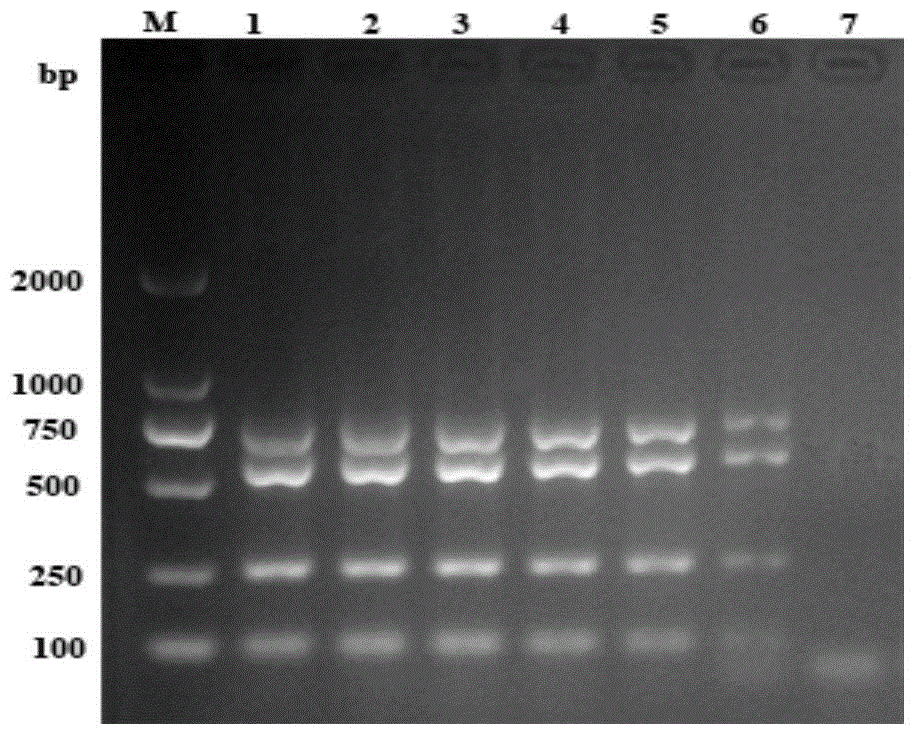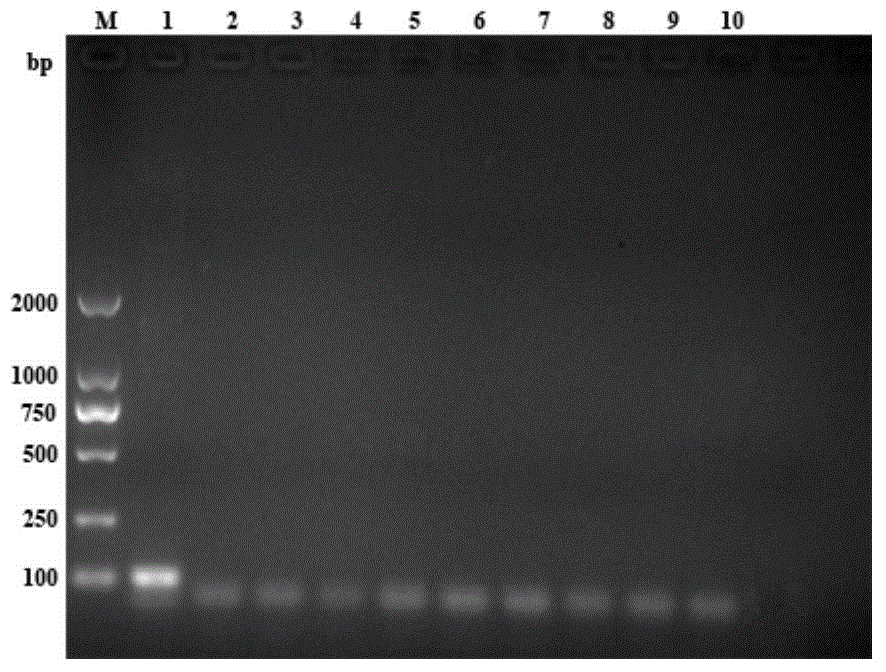Method for performing high-flux quick detection on food-borne pathogens by using multiplex PCR (polymerase chain reaction) technique
A food-borne pathogenic bacteria, multiple technology, applied in the direction of biochemical equipment and methods, microbe measurement/inspection, resistance to vector-borne diseases, etc., can solve the problems of incompetence, heavy workload, high cost, etc. With clear, strong specificity and high sensitivity
- Summary
- Abstract
- Description
- Claims
- Application Information
AI Technical Summary
Problems solved by technology
Method used
Image
Examples
Embodiment 1
[0052] The detection of embodiment 1 sample sensitivity
[0053] 1) Preparation of pork homogenate: Take 25 grams of pork that has been tested by national standards and confirmed to be free of the four food-borne pathogenic bacteria involved in this study, mince it and add 225 ml of sterilized physiological saline to homogenate.
[0054] 2) Bacteria culture: Inoculate Listeria monocytogenes, Salmonella, Escherichia coli O157:H7, and Staphylococcus aureus in LB liquid medium respectively, culture in an incubator at 37°C and shake at 220rpm overnight, and use plate counting method for colony counting.
[0055] 3) Acquisition of contaminated food samples as they are: Take 1 ml of each of the four pathogenic bacteria liquids of the same concentration that have been cultured overnight and add them to 7 ml of pork homogenate, mix them and use them as the original contaminated food samples.
[0056] 4) Multiplex PCR reaction: use the homogenate as the diluent to dilute the contamina...
Embodiment 2
[0061] The single multiplex PCR specific detection of embodiment 2 four kinds of bacteria
[0062] 12 strains: Salmonella, E. coli O157:H7, Listeria monocytogenes, Staphylococcus aureus, Klebsiella, Shigella flexneri, Proteus, Pseudomonas aeruginosa, Micrococcus luteus, pneumonia Streptococcus, Bacillus cereus, Enterobacter sakazakii.
[0063] Combine the food-borne pathogenic bacterial strains Salmonella, Escherichia coli O157:H7, Listeria monocytogenes, and Staphylococcus aureus of the present invention with the remaining 8 strains above, and perform single-plex PCR specificity detection, and mix them uniformly and separate The bacterial solution was used as a template for multiplex PCR amplification and electrophoresis detection.
[0064] The multiplex PCR reaction system, reaction conditions and product detection are carried out with reference to step 5) to step 7) of Example 1.
[0065] Results: The specificity of the primers of Salmonella, Listeria monocytogenes, Esche...
Embodiment 3
[0066] The multiple PCR specific detection of embodiment 3 four kinds of bacteria
[0067]12 strains: Salmonella, E. coli O157:H7, Listeria monocytogenes, Staphylococcus aureus, Klebsiella, Shigella flexneri, Proteus, Pseudomonas aeruginosa, Micrococcus luteus, pneumonia Streptococcus, Bacillus cereus, Enterobacter sakazakii.
[0068] Take any 3 of the food-borne pathogenic bacterial strains Salmonella, Escherichia coli O157:H7, Listeria monocytogenes, and Staphylococcus aureus of the present invention and 1 of the remaining 8 strains above to form 19 four kinds of bacterial strains. The strain combination was mixed evenly, and the bacterial solution was used as a template to carry out multiple PCR amplification and electrophoresis detection.
[0069] The multiplex PCR reaction system, reaction conditions and product detection are carried out with reference to step 5) to step 7) of Example 1.
[0070] Result: if Figure 6 , the multiplex PCR has strong specificity and can b...
PUM
 Login to View More
Login to View More Abstract
Description
Claims
Application Information
 Login to View More
Login to View More - R&D
- Intellectual Property
- Life Sciences
- Materials
- Tech Scout
- Unparalleled Data Quality
- Higher Quality Content
- 60% Fewer Hallucinations
Browse by: Latest US Patents, China's latest patents, Technical Efficacy Thesaurus, Application Domain, Technology Topic, Popular Technical Reports.
© 2025 PatSnap. All rights reserved.Legal|Privacy policy|Modern Slavery Act Transparency Statement|Sitemap|About US| Contact US: help@patsnap.com



